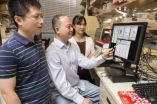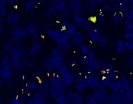(Press-News.org) By targeting RNA molecules that tangle and clump in the nervous systems of patients with the most common genetic form of amyotrophic lateral sclerosis (ALS or Lou Gehrig’s disease) and frontotemporal dementia (FTD), researchers have shown they can effectively limit those damaging elements in cells taken from patients. The results reported in the Cell Press journal Neuron on August 14th show that RNA is a viable drug target for the two overlapping and incurable neurodegenerative diseases. The abnormal proteins derived from that aberrant RNA might also serve as biomarkers in clinical trials to test the new ALS and FTD drug candidate and otherwise monitor the diseases, the new study finds.
ALS is caused by a progressive loss of motor neurons, leading to severe impairment of mobility, speech, swallowing, and respiratory function that is usually fatal within two to five years, the researchers explained. In FTD, brain regions that support higher cognitive function are affected instead to produce disabling changes in behavior, personality, and language. At present, no effective treatment is available for either condition. However, experts believe that a better understanding of the underlying disease processes will expedite the development of effective therapies, say Leonard Petrucelli of the Mayo Clinic and Matthew Disney of The Scripps Research Institute.
Indeed, Petrucelli, Disney, and their colleagues say that they were pleasantly surprised at how quickly they were able to identify a small molecule capable of interrupting the disease process in cells carrying the C9ORF72 gene. The disease variant is characterized by an expansion of repetitive DNA, which leads to the production of lengthy RNA tangles and the translation of abnormal proteins, both of which can apparently "set in motion distinct toxic chains of events that ultimately lead to neuronal death."
When the neurodegeneration targets motor neurons, the result is ALS. When it happens in brain regions that support higher cognitive function, then FTD develops. In some cases, affected people show signs of both conditions, which made it clear to Petrucelli and Disney that the aberrant RNA molecules were attractive targets for fighting the diseases.
In search of promising small molecules for the job, the research team first examined the shape of the culprit RNA. The goal then was to identify compounds capable of binding to it, and they got lucky.
"We found that the RNA repeat that causes c9FTD/ALS has some structural similarities to the RNA that causes fragile X-associated tremor ataxia syndrome, to which we already identified a small molecule that could affect dysfunction," Disney said.
By testing that compound and others that were chemically similar, they rather quickly identified two that selectively target c9FTD/ALS repeat RNA in cells. One of the two compounds cut the accumulation of RNA tangles in cell lines derived from ALS patients in half, they report, with no apparent toxicity. Petrucelli and Disney are now working on ways to improve it even further.
Importantly, the researchers also found that they could detect aberrant proteins in the spinal fluid of ALS patients with the C9ORF72 mutation, which might be useful when it comes to testing their compound or others in clinical trials.
"A decrease in the levels of c9RAN proteins in patient blood or cerebrospinal fluid in response to treatment would demonstrate the drug is working," Petrucelli said. "While additional studies must be done, this finding suggests that c9RAN proteins may provide a direct means to measure a patient's response to experimental drugs that target abnormal repeat RNA."
INFORMATION:
Neuron, Su et al.: "Biomarker and lead small molecule discovery to target r(GGGGCC)-associated defects in c9FTD/ALS."
RNA-targeted drug candidate for Lou Gehrig's disease found
2014-08-14
ELSE PRESS RELEASES FROM THIS DATE:
Disruption of gut bacteria early in life can lead to obesity in adulthood
2014-08-14
Certain microbes found in the gut may protect against obesity and diabetes. A study published by Cell Press August 14th in the journal Cell reveals that these microbes shape their hosts' metabolism very early in life and that disrupting them with short-term exposure to antibiotics during infancy can cause metabolic changes that appear to increase the risk of obesity in adulthood. These findings in mice are helping researchers identify which gut bacteria are crucial to metabolic health. Such information could be used to help restore levels of those helpful microbes after ...
New shock-and-kill approach could eradicate barrier to curing HIV
2014-08-14
Despite tremendous progress in combatting HIV-1 infection with antiretroviral therapy, there is still no cure for the disease because these drugs do not kill a hidden reservoir of infected cells in the body. A study published by Cell Press August 14th in the journal Cell reveals a multipronged strategy for eradicating this latent reservoir and preventing HIV-1 from rebounding after treatment is stopped in mice. The findings suggest that a "shock-and-kill" approach involving the activation of dormant viruses with drugs called inducers, combined with virus-fighting antibodies, ...
Early antibiotic exposure leads to lifelong metabolic disturbances in mice
2014-08-14
VIDEO:
Martin Blaser, M.D., and Laura Cox, Ph.D., discuss their work on early antibiotic exposure in mice.
Click here for more information.
NEW YORK, August 14, 2014 — A new study published today in Cell suggests that antibiotic exposure during a critical window of early development disrupts the bacterial landscape of the gut, home to trillions of diverse microbes, and permanently reprograms the body's metabolism, setting up a predisposition to obesity. Moreover, the study shows ...
Computation and collaboration lead to significant advance in malaria
2014-08-14
HOUSTON – (August 14, 2014) -- Researchers led by Baylor College of Medicine have developed a new computational method to study the function of disease-causing genes, starting with an important new discovery about a gene associated with malaria – one of the biggest global health burdens.
The work published today in the current issue of the journal Cell includes collaborators comprised of computational and evolutionary biologists and leading malaria experts from Baylor, Columbia University Medical Center, Princeton University, Pennsylvania State University and the National ...
Researchers identify a brain 'switchboard' important in attention and sleep
2014-08-14
VIDEO:
Michael Halassa, M.D., Ph.D. discusses his work with the thalamic reticular nucleus (TRN) and it's importance in identifying new targets for treating various psychiatric disorders like schizophrenia, autism and post-traumatic...
Click here for more information.
New York City, August 14, 2014 - Researchers at NYU Langone Medical Center and elsewhere, using a mouse model, have recorded the activity of individual nerve cells in a small part of the brain that works as a "switchboard," ...
Genetic signal prevents immune cells from turning against the body
2014-08-14
LA JOLLA—When faced with pathogens, the immune system summons a swarm of cells made up of soldiers and peacekeepers. The peacekeeping cells tell the soldier cells to halt fighting when invaders are cleared. Without this cease-fire signal, the soldiers, known as killer T cells, continue their frenzied attack and turn on the body, causing inflammation and autoimmune disorders such as allergies, asthma, rheumatoid arthritis, multiple sclerosis and type 1 diabetes.
Now, scientists at the Salk Institute have discovered a key control mechanism on the peacekeeping cells that ...
Common mutation successfully targeted in Lou Gehrig's disease and frontotemporal dementia
2014-08-14
JUPITER, FL, August 14, 2014 – An international team led by scientists from the Florida campuses of The Scripps Research Institute (TSRI) and the Mayo Clinic have for the first time successfully designed a therapeutic strategy targeting a specific genetic mutation that causes a common form of amyotrophic lateral sclerosis (ALS), better known as Lou Gehrig's disease, as well a type of frontotemporal dementia (FTD).
The scientists developed small-molecule drug candidates and showed they interfere with the synthesis of an abnormal protein that plays a key role in causing ...
Scientists use lasers to control mouse brain switchboard
2014-08-14
VIDEO:
Scientists studied how just a few nerve cell in the mouse brain may control the switch between internal thoughts and external distractions. Using optogenetics, a technique that uses light-sensitive molecules...
Click here for more information.
Ever wonder why it's hard to focus after a bad night's sleep? Using mice and flashes of light, scientists show that just a few nerve cells in the brain may control the switch between internal thoughts and external distractions. The ...
Long antibiotic treatments: Slowly growing bacteria to blame
2014-08-14
Whether pneumonia or sepsis – infectious diseases are becoming increasingly difficult to treat. One reason for this is the growing antibiotic resistance. But even non-resistant bacteria can survive antibiotics for some time, and that's why treatments need to be continued for several days or weeks. Scientists at the Biozentrum of the University of Basel showed that bacteria with vastly different antibiotic sensitivity coexist within the same tissue. In the scientific journal Cell they report that, in particular, slowly growing pathogens hamper treatment.
Many bacteria ...
Tissue development 'roadmap' created to guide stem cell medicine
2014-08-14
In a boon to stem cell research and regenerative medicine, scientists at Boston Children's Hospital, the Wyss Institute for Biologically Inspired Engineering at Harvard University and Boston University have created a computer algorithm called CellNet as a "roadmap" for cell and tissue engineering, to ensure that cells engineered in the lab have the same favorable properties as cells in our own bodies. CellNet and its application to stem cell engineering are described in two back-to-back papers in the August 14 issue of the journal Cell.
Scientists around the world are ...





